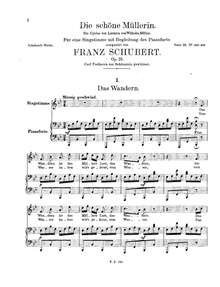Die schöne Müllerin

Die schöne Müllerin (Op. 25, D. 795), is a song cycle by Franz Schubert based on poems by Wilhelm Müller. It is the earliest extended song cycle to be widely performed. The work is considered one of Schubert's most important cycles, and one of the pinnacles of Lied, and it is widely performed and recorded.

Die schöne Müllerin is performed by a pianist and a solo singer. The vocal part falls in the range of a tenor or soprano voice, but is often sung by other voices, transposed to a lower range. Since the story of the cycle is about a young man, the work is most often sung by men. The piano part bears much of the expressive burden of the work, and is only seldom a mere "accompaniment" to the singer.
A typical performance lasts around sixty to seventy minutes.
Composition
Müller's poems were published in 1820, and Schubert set most of them to music between May and September 1823, while he was also writing his opera Fierrabras. He was 26 years old at the time. Schubert omitted five of the poems, such as a prologue and an epilogue delivered by the poet. The work was published in 1824 by the firm of Sauer and Leidesdorf as Op. 25 under the title Die schöne Müllerin, ein Zyklus von Liedern, gedichtet von Wilhelm Müller, which means, "The Lovely Maid of the Mill, a song cycle to poems by Wilhelm Müller", and was dedicated to Carl von Schönstein.
Narrative
There are twenty songs in the cycle, around half in simple strophic form, and they move from cheerful optimism to despair and tragedy. At the beginning of the cycle, a young journeyman miller wanders happily through the countryside. He comes upon a brook, which he follows to a mill. He falls in love with the miller's beautiful daughter (the "Müllerin" of the title). She is out of his reach as he is only a journeyman. He tries to impress her, but her response seems tentative. The young man is soon supplanted in her affections by a hunter clad in green, the color of a ribbon he gave the girl. In his anguish, he experiences an obsession with the color green, then an extravagant death fantasy in which flowers sprout from his grave to express his undying love. (See Beethoven's Adelaide for a similar fantasy.) In the end, the young man despairs and presumably drowns himself in the brook. The last number is a lullaby sung by the brook.
Editions
The Diabelli edition of 1830 in a facsimile score, with notes by Walther Dürr, was published (1996) by Bärenreiter.[1] The version in most common use is the Peters Edition, edited by Max Friedlaender, and in this and several other editions (e.g. Schirmer) the cycle is presented as the first 20 songs of Volume 1. There are versions in the original (high) keys, and transposed alternatives for lower voices. The Peters edition was revised by Dietrich Fischer-Dieskau and Elmar Budde, and is available as Volume 1 of the Peters Urtext Edition,[2] available in high, medium and low key versions. The most recent scholarly edition is in the New Schubert Edition, again edited by Walther Dürr and published by Bärenreiter,[3] and contains transposed versions for lower voices.
Six of the songs were transcribed for piano by Franz Liszt and published as Müllerlieder.[4]
Song titles and keys
(Title translations from the International edition)
- "Das Wandern" ("Wandering Miller"; B-flat major)
- "Wohin?" ("Where to?"; G major)
- "Halt!" ("Stop!"; C major)
- "Danksagung an den Bach" ("A Song of Thanks to the Brook"; G major)
- "Am Feierabend" ("Rest at the End of the Day"; A minor)
- "Der Neugierige" ("The Inquisitive One"; B major)
- "Ungeduld" ("Impatience"; A major)
- "Morgengruß" ("Good morning"; C major)
- "Des Müllers Blumen" ("The miller's flowers"; A major)
- "Tränenregen" ("Shower of tears"; A major)
- "Mein!" ("Mine!"; D major)
- "Pause" ("Interlude"; B-flat major)
- "Mit dem grünen Lautenbande" ("With the green lute-riband"; B-flat major)
- "Der Jäger" ("The hunter"; C minor)
- "Eifersucht und Stolz" ("Jealousy and pride"; G minor)
- "Die liebe Farbe" ("The Beloved colour"; B minor)
- "Die böse Farbe" ("The Evil colour"; B major)
- "Trockne Blumen" ("Withered flowers"; E minor)
- "Der Müller und der Bach" ("The miller and the brook"; G minor)
- "Des Baches Wiegenlied" ("The brook's lullaby"; E major)
References
- ↑
- ↑
- ↑
- ↑ Publisher's Note pp. ix-x in Franz Liszt: The Schubert Song Transcriptions for Solo Piano: Series II: The Complete Winterreise and Seven other Great Songs, 1996, Mineola, N.Y.,Dover Publications inc.
External links
- Die schöne Müllerin: Scores at the International Music Score Library Project
- Original German and English translations of the texts
- Performance of Die schöne Müllerin by Randall Scarlata (baritone) and Jeremy Denk (piano), from the Isabella Stewart Gardner Museum in MP3 format
- Müller's complete text, read in German at librivox.org (N. 19)
- Notes on Die schöne Müllerin by Franz Schubert & Wilhelm Müller - notes, texts, translations, and links
- Free piano accompaniment tracks